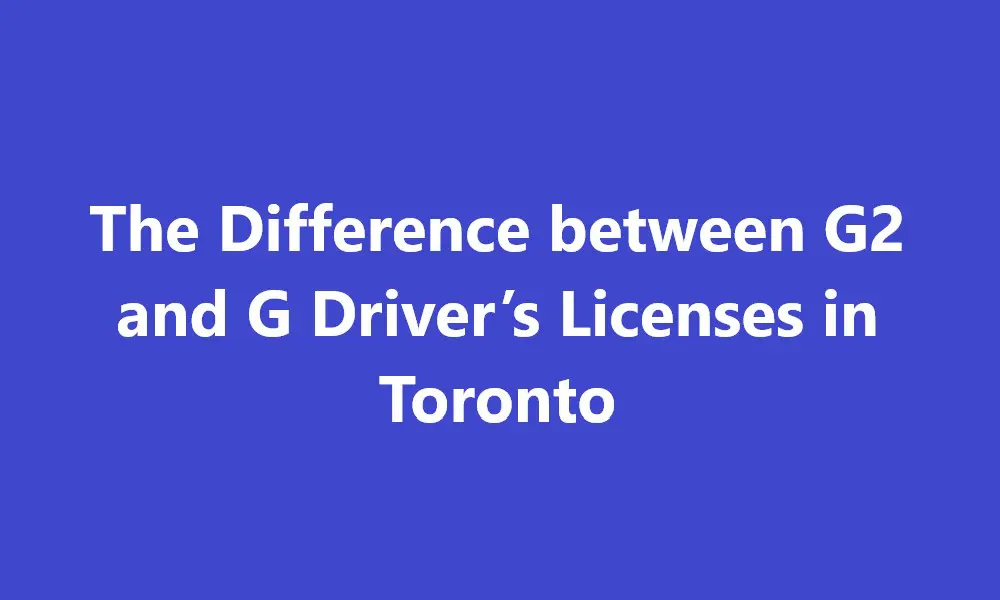
The Difference between G2 and G Driver’s Licenses in Toronto
G2 and the G license are undoubtedly phrases you’ve heard of if you want to get your driver’s license in Toronto. Knowing how these licenses vary from one another and to what degree might be difficult to grasp. This post will explain the differences between the G2 and G licenses and break down Toronto’s graduated licensing system.
Difference between G2 and G Driver’s License
The three tiers in Toronto’s system are G1, G2, and the G license. Since new drivers gradually advance in their knowledge and competence, each level has its prerequisites.
For the protection of novice drivers and other road users, the G1 license is the lowest level, with various prohibitions and restrictions in place. During midnight and five in the morning, for instance, they may not drive. As you work toward earning a complete driver’s license, the G2 level gives you more freedom and fewer limitations. In contrast, the G license represents the highest level of driving freedom offered under the tiered system.
The G license denotes complete driving freedom, while the G2 is similar to a stepping stone toward obtaining full driving rights. Irrespective of the license you have in your pocket, always drive carefully!
- Privileges
You can still drive, but there are some limitations, even with a G2 license. To operate a car, for example, you must have a 0.00 BAC (Blood Alcohol Concentration).
You get your full G license after passing the G exam. Your driving rights in Toronto will be at their most outstanding level after this. Your driving freedom is unrestricted with a G license; you may even work as a driving examiner or teacher.
Driving at any time, place, and with any person you want is possible with your G license. You may drive on all of Toronto’s roads and highways, as well as throughout Canada, if you’d like to take a road trip, with no limitations on passengers or time.
- Restrictions
Among the limitations of the G2 license are the following:
- Blood Alcohol: You have to keep your blood alcohol content at zero.
- 12-Month Practice Period: You have a whole year to practice driving on any Toronto road at any time, using your G2 license without requiring an additional experienced driver to accompany you.
- Every passenger must wear a seatbelt: You can only transport as many people as seatbelts are in operation.
There are further limitations if you are 19 years old and younger. These relate to the amount of passengers and the times you may drive. They include:
- Restrictions on night driving for the first six months: For the first six months, you must drive between midnight and five in the morning with a single passenger who is 19 or younger.
- Restrictions on night driving after six months: After the first six months, you may drive between midnight and five in the morning with up to three passengers who are 19 years of age or younger.
- Exemptions from nighttime driving restrictions: These terms do not apply if the driver in the vehicle is a fully licensed driver with at least four years of driving experience or if the other passengers are members of the driver’s immediate family, such as a parent, brother, or sister.
A G license allows you to drive unrestrictedly and even pursue careers as a driving teacher or examiner, unlike a G2 license.
- Tests – Comparing G2 & G Tests
To get a G2 license, you must pass the G1 road test. It takes around fifteen minutes and is also known as the G1 exit exam in Toronto. It just assesses fundamental driving abilities, such as beginning and stopping. It also addresses lane changes, parallel and perpendicular parking, and safe turning.
The G2 exit test is also known as the “level two road test” or the G driving exam. Advanced knowledge and abilities, which are often acquired only via experience, are tested. In addition, prospective G examinees will be tested on highway driving such as merging, lane changes and exiting highway. This should take 30 to 40 minutes if there are more test components.
Although the G2 and G tests give one access to highways, they vary in a few ways. With fewer driving situations, the G2 exam is less thorough than the G test. The G test also calls for greater driving competency and more expertise.
- Time of Acquisition
As per Toronto’s regulations, all applicants seeking G2 licenses must wait a year before applying. The waiting time begins when the person receives their G1 license. However, there is an alternative method to shorten the customary year-long waiting time.
Let’s now discuss the G license. You can take the G road exam, which covers advanced driving techniques and highway driving, if you have had your G2 license for at least a year.
- Cost
Testing costs are another distinction between the G2 and full G license. To get a G2 license and a G license, you must pass the G2 and G tests. You must pay the necessary amount whether enrolling for the G2 or the G exam.
Conclusion
In conclusion, passing the G2 and G exams is necessary to earn a Toronto driver’s license. You can confidently handle the licensing procedure if you know the distinctions between these examinations and the various license levels.
The main difference between the two licenses is that once attained, G license remains permanent some exceptional circumstances withstanding while the G2 license will downgrade to G1 if the user doesn’t get G in five years from starting.
Contact Yusra Driving School a driving school in Scarborough to get driver’s licenses in Toronto.
Suggested Reads:
